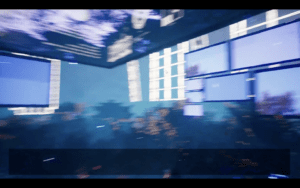For me, interaction was the perception and execution of indications from one another. The closest analogy to it would be the a dialogue. By understanding the object’s words, the subject gives corresponding reposes and vice versa. In short, as Crawford proposed, it should be as “a cyclic process in which two actors alternately listen, think, and speak.” (1) So in the case of human-machine interaction, unlike common understanding, I consider it as that people, after having the machine proceeding their indications should respond in an understandable way for machine. Even if it was the end of conversation, we, the human, would wave each other goodbye. Thus, to the machines, we should do the same, presenting them with the rudimental respect by responding in a comprehensive manner. Sadly, a negative example against my definition was what we made in the recitation class, the circuit accepting one-off commands from human, which is shown hereIMG_2285, though I have to admit I have defined interaction upon very much of a narrow sense.
Whereas our development in technologies, to say, new media, developed, the definition of man-machine interaction have a rather obvious tendency towards Crawford’s theory as well as mine. A decade ago, the definitions might still be out of reach in certain fields, but nowadays, we are able to satisfy the standards. Manovich, in The Language of New Media, also pointed out sci-tech’s intermittent impact on man-machine relation, which were that “a new media object is subject to algorithmic manipulation”(27), as new media could be mathematically represented(27). He put forward the quintessential case where the media access was actually subjected to increasing automation, which resulted in the growing comprehensive ability of machines towards human activities(34), say the NLP(Nature Language Processing) used for searching engines. As technologies developed, the import and export of the machines developed, which could be seen from the artifact “We Spoke of the Same Bright Moon”(《我们共诉一轮明月》, https://www.manamana.net/video/detail?id=1930184#!zh). It was a visual reality game where a system was created as another world in media, a poetic craft from the authors imaginations. Everything that should react as in the real life, react the same way they should react in in this world existing only in digital dimension. The water waves as the users steps on; the guiding gold fish goes the way you go; the light changes from different degree and different time. (临Lyn, n.d.)
Moreover, they even included specific guidance for each step floating at front as the users proceeds. Certain moves of the user might trigger the guidances to emerge. The machine, or more specifically, the program of the game, understands the moves made by human and could react to them in a understandable, thanks to certain principles from the physical world that the game followed, while human, on receiving the emerging information, say, the guidances, react also in a understandable way for the gamete program. The case can’t explain my definition of interaction better.
To sum up, interaction consists of the triggering move by the subject, and plural responses from both sides, the subject and the object, as well as, the stress-worthy ending indication from either side.